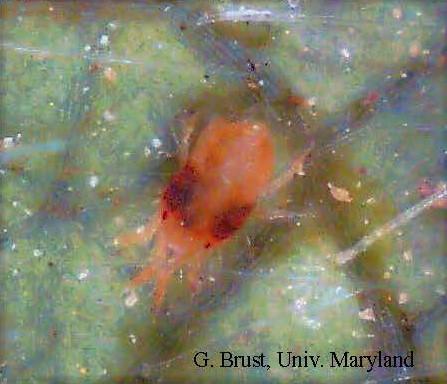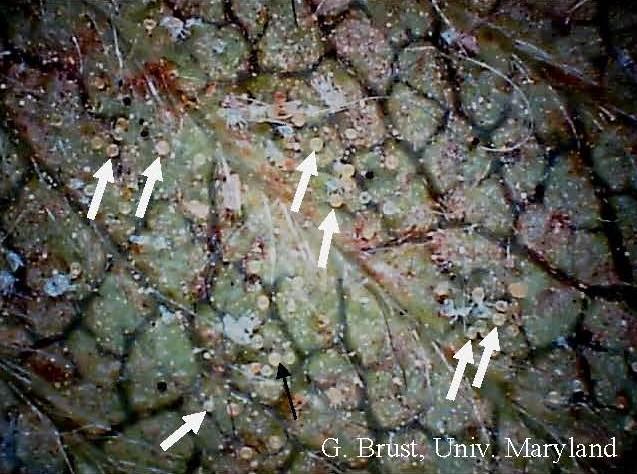
Fig1 Overwintered two spotted spider mite female with orangish-red coloration.
I visited some strawberry fields over the last few weeks in Maryland and while most of the fields were on plastic, some were matted row production. Overall I found low levels of mites in most of the fields, with a few hot spots. There was only one species of mite found: the two spotted spider mite, Tetranychus urticae. Overwintering female two spotted spider mites are an orangish-red (fig. 1) and most of the mites that can be seen with a naked eye will appear reddish in color. Spider mites overwinter in the soil or leaf litter, although they may remain somewhat active in high tunnels through the winter.

I found mite eggs in several locations. The light yellowish eggs are pearl-like in appearance and are attached to the underside of leaves or stems (fig. 2). Feeding damage by mites that occurs before fruiting can cause the most yield loss, but after the first strawberry harvest plants can tolerate much greater rates of infestation. Growers should check their strawberries for mites now, especially if you have them in a high tunnel. If you find mites you will need more than 5 per leaflet (1/3 of a leaf) to justify the expense of a miticide application.
The most difficult thing to achieve for good mite control is getting adequate spray coverage. Many of the spray applications do a good job of covering the top of the leaves but do a poor job of reaching the underside of the trifoliate. The underside area of the leaf that usually sees very little chemical deposition is in the ‘palm’ of the leaf. This is the area where mites can still be found even after a few sprays and need to be carefully checked a few days after an application. Good coverage is essential. One grower uses a backpack fogger-atomizer sprayer and applies two sprays of 1% (by volume) horticultural oil 7-10 days apart. The grower achieved excellent spray coverage on the underside of leaves and consequently excellent control of mites. By using two applications about one week apart it is possible to control not only the adults and nymphs, but the eggs as well. Oil is a good management tactic to use at this time of year as the plants are small and any phytotoxic response from using the oil is a low risk. An added benefit of the oil is that it is rather inexpensive.
I would like to see more growers use something like oil now and save the other chemicals for later in the season when plants are larger and there is a flare up of mites or other pests. Using oils now will also greatly reduce any development of mite resistance to other chemicals over the course of the season. If miticides are needed there are many excellent miticides available such as Agri-Mek, Acramite, Portal, etc. that can be found in the 2020/2021 Mid-Atlantic Commercial Vegetable Recommendations guide.
Return to Vegetable Insect IPM
This article appears on May 13, 2021, Volume 12, Issue 2 of the Vegetable and Fruit News
Vegetable and Fruit News, May 2021, Vol. 12, Issue 2
Vegetable and Fruit News is a statewide publication for the commercial vegetable and fruit industries and is published monthly during the growing season (April through October). Subscribers will receive an email with the latest edition.
Subscribe